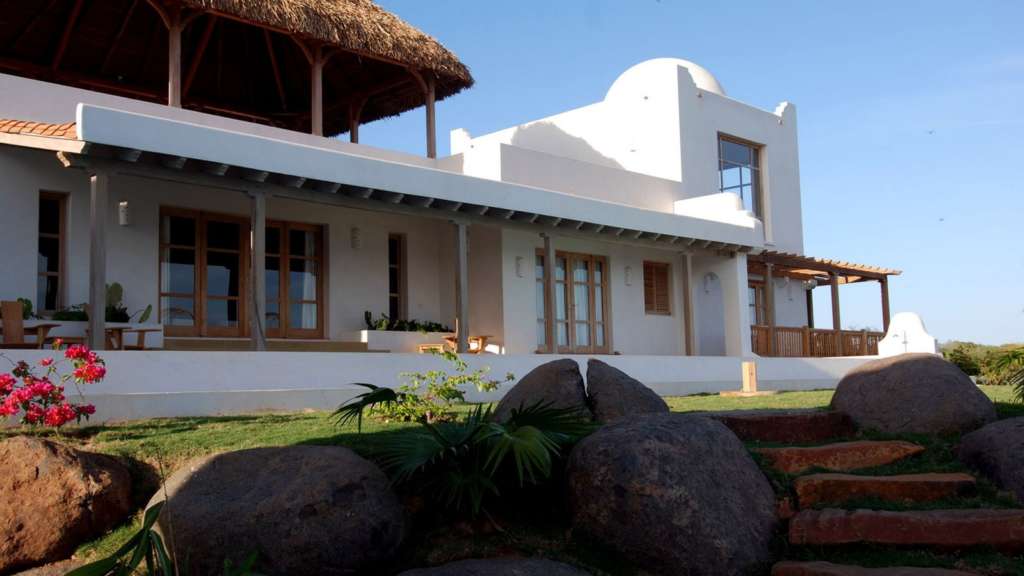This sprawling Mediterranean-style house is in Pedasí, on the southeastern tip of the Azuero Peninsula in Panama. The once sleepy fishing community, on the Pacific Coast about 200 miles south of Panama City, is becoming increasingly popular as a vacation and retirement destination.
The white concrete structure with a terra-cotta tile roof has two stories and 15,812 square feet of interior space. It sits on nearly 1.3 acres with direct access to more than a mile of private beach and numerous resort-style amenities within its property, including an infinity pool, a dining pavilion and a rooftop terrace with a thatched covering. The furniture is included in the price.
The house has six spacious en-suite bedrooms, each with walk-in closets. There is also a media room, an art studio that was converted from guest quarters, a breakfast bar in the kitchen and two partial baths.
A grand foyer with double-height ceilings opens to a central courtyard with direct water views. Oversize windows and numerous balconies and terraces look out over the ocean and lush tropical gardens, providing an almost seamless connection to the outdoors.
The foyer is flanked by two large living rooms, each outfitted with contemporary furnishings. The formal dining room also flows into the courtyard.
The Spanish owners had the house built in 2010 and used it as a second residence for six to eight months a year, said Rafael Gangi, the president of Panama Sotheby’s International Realty, which is listing the property. They incorporated many natural materials into the design, he said, including mahogany and oak, terra-cotta and marble tile, as well as mosaic finishes from India.
Pedasí, a town of about 4,000 people, is known for its pristine beaches, sport fishing, diving and surfing, and is close to several national parks and preserves, including the Isla Iguana Wildlife Refuge. The development of the area has increased in recent years, with new homes and hotels steadily cropping up.
Pedasí is in the province of Los Santos, which has a population of around 90,000. Tocumen International Airport, a regional hub and one of the busiest airports in Central America, is about 225 miles away. The smaller Pedasí Airport is just outside town.
Market Overview
The housing market in Panama slowed significantly after the 2008 global financial crisis, with prices falling, on average, 20 to 30 percent, according to Kent Davis, a managing director of Panama Equity Real Estate. He said the drop was not as pronounced in the Pedasí district.
The real estate market began to rebound after 2012 as buyers, many of them foreigners, returned from the sidelines with more confidence and in search of deals. Mr. Gangi of Sotheby’s said he expects sales over all to rise around 6 percent this year.
Luxury homes near the beach in Pedasí start at around $800,000. But there are plenty of less expensive options away from the water, Mr. Davis said. Two-bedroom, two-bath houses farther inland can often be purchased for below $200,000, he said.
Who Buys in Panama
Most luxury properties are acquired by buyers and investors from the United States, Canada, Europe and Latin America, agents say.
Buyers come to Pedasí, in particular, looking for vacation or retirement homes. “Retirees love it there,” Mr. Davis said. “The area is super-safe, and there’s a small-town community feel.”
But, he added, “The retirees there aren’t the type to play golf all day. Many of them run businesses or start businesses.”
Buying Basics
Foreign buyers generally do not face restrictions on real estate purchases in Panama. The government has tried to encourage investments and new developments with incentives such as property tax exemptions.
Local financing, however, can be challenging to secure, according to Berta A. Sanchez, a real estate lawyer with offices in Pedasí and Panama City, and loan terms may be less attractive than those in the United States.
“The buyer must have Panamanian residency,” Ms. Sanchez said, adding, “Panamanian banks are very cautious granting mortgages.”
Agents recommend that buyers hire a real estate lawyer to guide them through the process, which usually takes one to three months to complete. “Due diligence is crucial in any real estate transaction,” Ms. Sanchez said, noting that buyers will need to ensure clear title to a property and verify any applicable property tax exemptions, among other things.
Real estate purchases may be made individually or through a corporation established in Panama, she said. Ownership is usually finalized once a deed is recorded at the Public Registry Office.
Languages and Currency
Spanish; Panamanian balboa, American dollar (1 balboa = $1)
Taxes and Fees
Sellers typically pay the sales commission, which ranges from 4 to 8 percent of the purchase price. They also pay a 2 percent transfer tax and 3 percent tax on capital gains, according to Ms. Sanchez.
She said buyers are responsible for any notary fees and registration fees at the Public Registry, which are 0.3 percent of the sales price.
This house was exempted from property taxes for 20 years, with 13 left, according to Mr. Gangi, as part of Panama’s tax exoneration program.
The New York Times
